Creating a pollinator-friendly yard or garden has numerous benefits. You get to benefit from the gorgeous flowers that attract pollinators. Additionally, you can trust that your plants will be pollinated by the best in the business! But the benefits extend beyond that, especially when you incorporate plants that attract bees into your outdoor space.
Pollinators create an ecologically rich, biodiverse space. Their presence will benefit all your plants. There is no downside. However, selecting plants that attract bees is particularly important. With global bee populations dwindling, anything we can do to support our little flying friends will make a huge difference. So if you are interested in developing a bee-friendly garden, keep reading. Below we explore nine plants that attract bees, their growing requirements, where you can buy seeds, and more.
1. African Marigold (Tagetes erecta)
This lovely plant is the ideal first plant for young children or first-time gardeners to grow.
Why They Attract Bees:
The brightly colored flowers of Tagetes erecta create a perfect place for bees to come feast.
Description:
African marigolds are a larger species than some of the other marigolds. The sturdy plant can grow up to 3-4 feet high. It produces double flowers that can reach up to 5 inches in diameter.
Marigold flowers are always brightly colored. Possible colors available for purchase include oranges, yellows, reds, golds, and whites.
USDA Hardiness Zones:
Zones 2-11 all make the perfect home for marigolds.
Sourcing:
You can pick up a pack of marigold seeds wherever you buy your vegetable seeds.
Growing Conditions:
Plant your marigolds in a spot that will receive full sun, and they will thrive. The location can be in your yard or garden, on your patio, or in a sunny spot in your home (if you choose a smaller species).
You can start Tagetes erecta inside earlier in the season. Or you can sow the seeds directly once the weather has warmed up. You do not need to be overly concerned about watering them, as they prefer less water and are drought-tolerant.
Bonus:
Marigolds make a fantastic addition to companion planting as their scent deters many pests.

African Marigolds attract bees with their flavorful nectar.
©FunFamilyRu/Shutterstock.com
2. Borage (Borago officinalis)
Borage is a standout plant, perfect for any garden, outdoor space, or patio container. It is a delight to look at and is sure to be the talk of the neighborhood.
Why They Attract Bees:
Bees love to visit the droopy flowers, hiding amongst the petals as they feed.
Description:
You cannot miss the distinctive borage plant despite its relatively short stature. It only grows between 1-3 feet tall and has a spread of up to 1.5 feet.
Its shockingly blue flowers typically bloom from June to August. They are star-shaped and droop to create an exquisite floral display. Its stem and tiny hairs cover the leaves. The leaves are a gray-green color, dull, and wrinkled.
USDA Hardiness Zones:
Feel free to add borage to your garden if you live in Zones 2-11.
Sourcing:
You can find borage seeds at online seed suppliers and local nurseries.
Growing Conditions:
Borago officinalis are low-maintenance plants and require light to moderate watering. Plant them in an area that receives full to partial sun for the best results. This delightful plant does best in well-draining soil. But it is tolerant of poor soil conditions and drought.
You can sow borage seeds directly or start them in indoor seed trays. And while it is technically an annual, it will self-seed in many hardiness zones. So you may end up with a surprise borage plant or two next year.
Bonus:
You can eat the edible leaves just as you would spinach. They have a flavor reminiscent of cucumber.
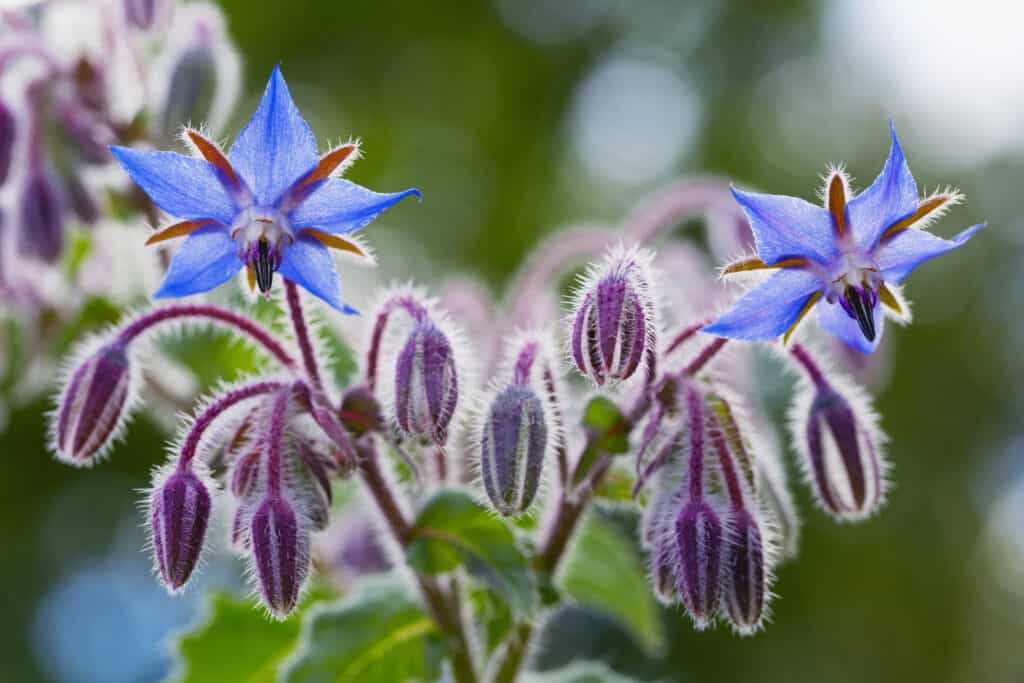
The scent of borage flowers entices bees to come feed.
©matteo sani/Shutterstock.com
3. Wild Bergamot (Monarda fistulosa)
Wild bergamot is an herbaceous perennial and part of the Lamiaceae (mint) family.
Why They Attract Bees:
This stunning flower is a favorite among all pollinators. Its delicious nectar provides ample food for all its little visitors, including bees.
Description:
The wild bergamot plant grows relatively short in stature, only reaching 3-4 feet high and the equivalent in width. Its lavender/pink floral display arrives in July and stays through September.
Wild bergamot flowers are tubular, two-lipped, and perch upon pink, showy, leafy bracts. The leaves are gray-green, oblong, and toothed.
USDA Hardiness Zones:
Wild bergamot is hardy in Zones 3-9.
Sourcing:
You can find wild bergamot seed packets at many local nurseries. Alternatively, consider purchasing from online seed companies that specialize in native wildflowers.
Growing Conditions:
Monarda fistulosa is incredibly easy to grow. It requires light to medium watering and can tolerate partial shade. It is drought-tolerant and can survive in poor soil conditions. So you can grow wild bergamot in areas where other plants won’t survive.
Bonus:
Butterflies adore wild bergamot, and you can include its leaves in your herbal tea.
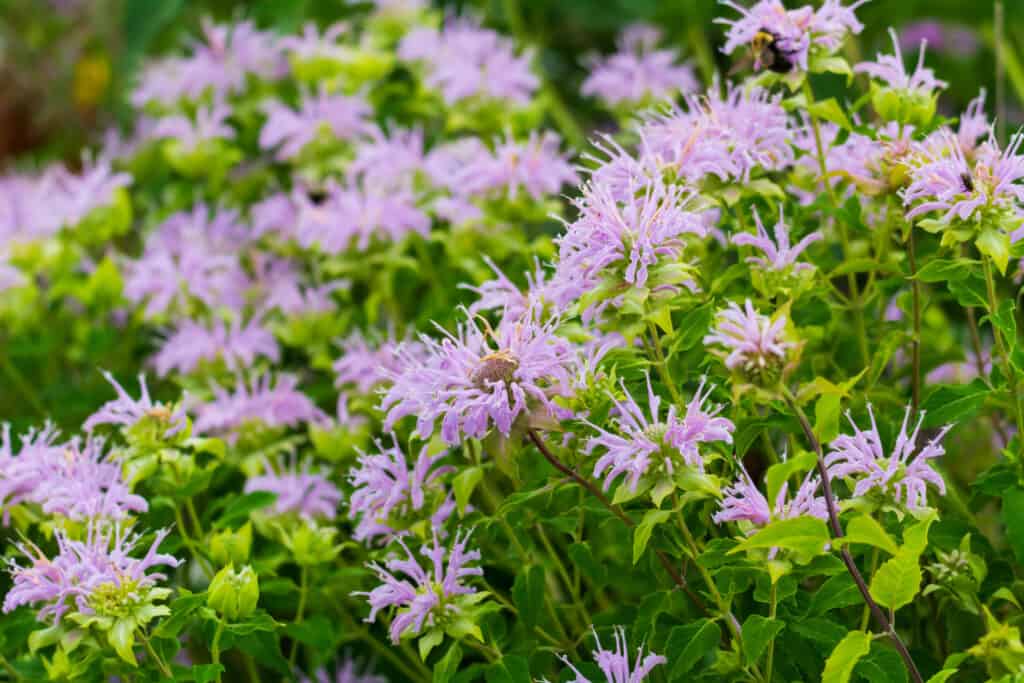
Wild Bergamot flowers have tasty nectar that bees love.
©James W. Thompson/Shutterstock.com
4. Nasturtium (Tropaeolum majus)
This stunning flower provides wonderful ground cover or addition to garden trellises and walls. You can also successfully grow it in containers if you are short on space.
Why They Attract Bees:
The bright colors and flavorful nectar of nasturtium are beloved by all pollinators, especially bees.
Description:
The leaves of Tropaeolum majus are very distinctive. They are nearly circular and shield-shaped, with light-colored veins extending from the center. The size of the leaves varies, depending on the plant, but can reach a width of up to 4 feet. Nasturtiums grow as either low mounds or trailing plants.
Its flowers almost always have five petals, with a narrow nectar spur in the center. They come in extraordinarily bright hues of oranges, yellow, red, jewel-tones, and cream.
USDA Hardiness Zones:
Nasturtiums are perennials in Zones 9-11 and are grown as annuals in all other zones.
Sourcing:
You can find the most common nasturtium varieties at your local nursery. Or check out online seed companies for more unique and stunning options.
Growing Conditions:
This easy-to-grow plant needs full sun and well-draining soil. They don’t require fertilization unless your soil quality is poor.
Bonus:
The edible leaves have a peppery flavor, adding a nice bite to any salad.
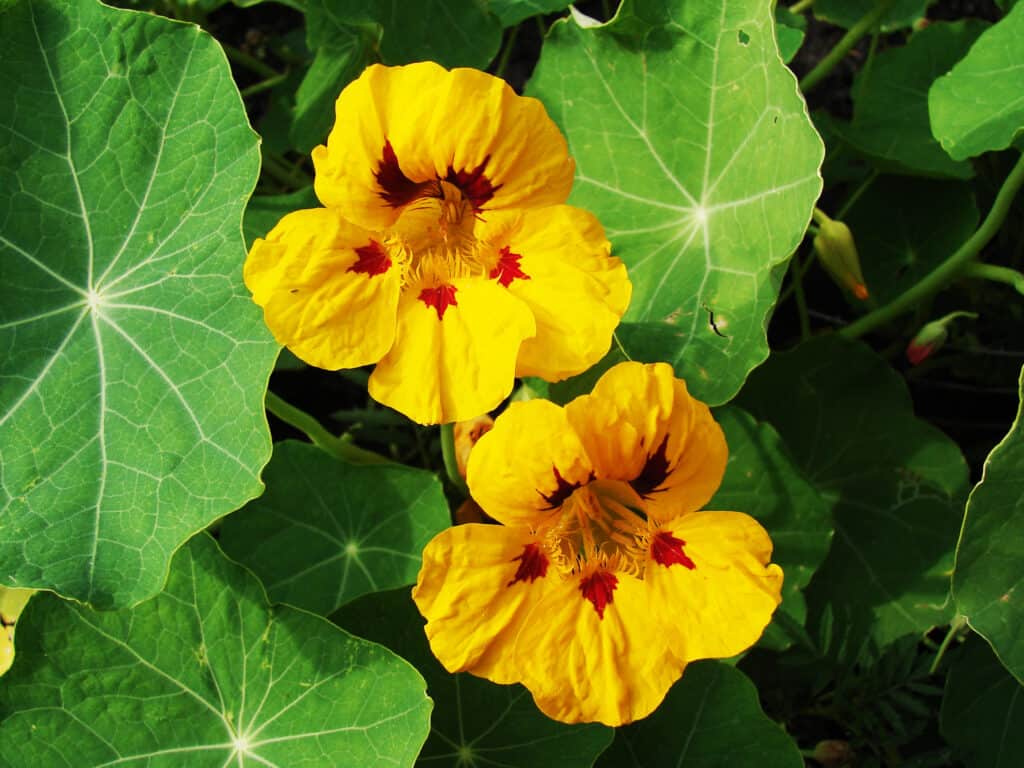
The bright colors and delicious nectar of nasturtium flowers draw bees in.
©Minos23/Shutterstock.com
5. Bee Balm (Monarda didyma)
Bee balm is an herbaceous perennial in the Lamiaceae (mint) family and is native to North Carolina. Due to its lineage, the leaves of bee balm have a delightful minty aroma when crushed.
Why They Attract Bees:
As the name suggests, bee balm nectar is a favorite of the tiny pollinators.
Description:
Bee balm plants can reach up to 4 feet in height. The stem is square and erect, with opposite and coarse leaves. Its flowers are two-lipped and have thin, elongated corolla tubes.
USDA Hardiness Zones:
Perfect for gardens and yards in Zones 3-9.
Sourcing:
Seed packets are readily available at nurseries and online seed shops.
Growing Conditions:
Plant bee balm in well-draining and rich soil. This beautiful plant needs ample sunlight, so select a nice, bright spot.
Bonus:
After the bees have gotten their fill and pollinated your bee balm, consider harvesting a few flowers for your own use. Monarda didyma is well known for its medicinal value, and its flowers are edible.

Bee Balm flowers are the preferred food for bees.
©nnattalli/Shutterstock.com
6. Purple Coneflower (Echinacea purpurea)
This herbaceous perennial is in the large Asteraceae (daisy) family. The flowers stick around for a long time, making them a favorite plant for pollinator-friendly and native garden spaces.
Why They Attract Bees:
The large flower heads offer a rich source of nectar for bees and are an ideal addition to a pollinator garden.
Description:
The lovely coneflower plant can grow as tall as 3 to 4 feet. It produces distinctive light purple flowers. However, you can find cultivars with different colored flowers. Its terminal, brown-domed flower heads are surrounded by 1-2 rows of drooping ray flowers. And the long, narrow leaves are rough to the touch.
USDA Hardiness Zones:
Perfect for outdoor spaces in Zones 4-9.
Sourcing:
You only need to buy the seeds once, which you can find wherever you purchase your seed packets. Echinacea purpurea will reseed itself for future years.
Growing Conditions:
Purple coneflowers are exceptionally easy to grow and care for. While they prefer moist and rich loamy soil, they can adapt to many soil types. Plant them in a well-draining area with full to partial sun exposure.
Bonus:
Echinacea purpurea is prized for its medicinal value. Additionally, when you leave some of the flower head and let it go to seed, you will attract birds.
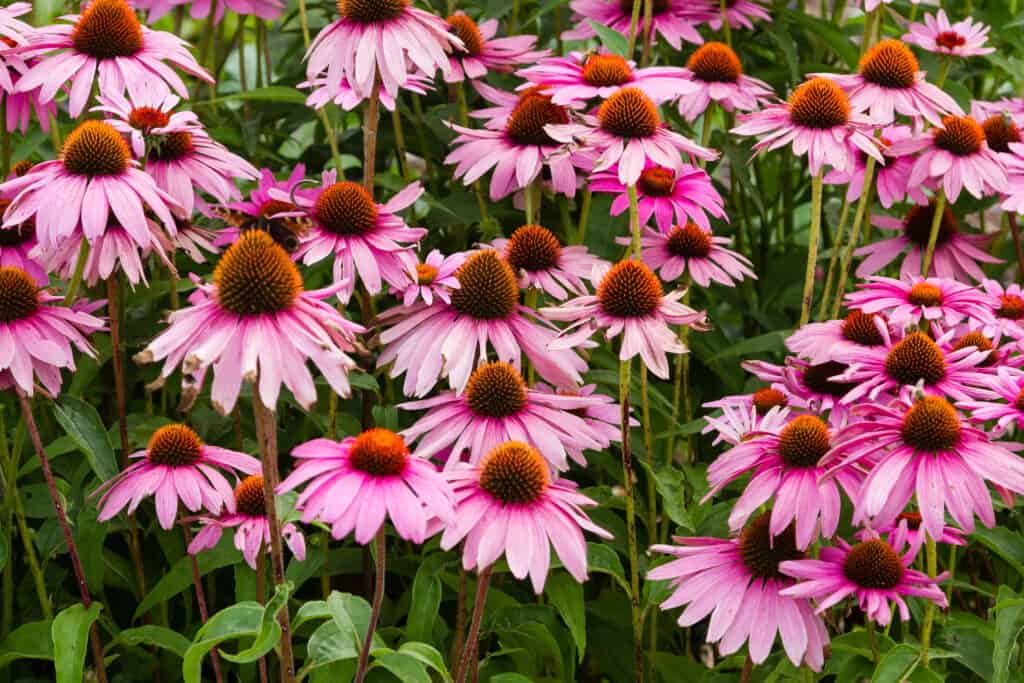
Purple coneflowers have large heads that provide a rich source of nectar for bees.
©Milosz Maslanka/Shutterstock.com
7. Aster (Aster)
With over 250 Aster species available, you can find a truly unique and beautiful plant that best suits your style.
Why They Attract Bees:
The nectar-rich flowers are a lovely snack for hungry bees.
Description:
Aster plants can grow from 6 inches to 8 feet tall. The plants are mounding and erect. And depending on which species you choose, you may find stems with multiple branches or a single branch. The leaf size and shape will also vary greatly.
However, aster flowers are quite distinctive. They have a daisy-like appearance, with disc florets that are either yellow or white. The rays around the florets come in shades of purple, blue, white, and pink.
USDA Hardiness Zones:
Consider adding these lovely flowers to your yard if you live in Zones 3-8.
Sourcing:
You can purchase seeds from an online shop or local nursery. But aster can also be propagated by stem or root cuttings.
Growing Conditions:
Aster is incredibly easy to grow, making it the ideal choice for new and seasoned gardeners alike. But each species has slightly different preferences. So, when you choose one, note what that particular species likes. Some prefer partial shade, others full sun. Similarly, some are drought-tolerant, and others are not.
However, all aster plants love clay or rich, loamy soil. They grow well in garden beds, as hedges, or in containers.
Bonus:
Since they bloom later than many flowers, aster is a wonderful option for attracting bees as the evenings begin cooling off.

Aster flowers are nectar-rich and a favorite spot for bees to come feast.
©Volodymyr Yakovyna/Shutterstock.com
8. Snapdragon (Antirrhinum majus)
Snapdragons are a beloved flower commonly added to gardens, patios, and window boxes. And pollinators adore brightly colored flowers. So when you plant some, you not only get the joy of admiring your beautiful flowers, but you also create a rich biodiverse environment.
Why They Attract Bees:
Snapdragons are a rich source of nectar for bees. Bees reach it by landing on the lower flower lobe and crawling in between the two lips.
Description:
There are many snapdragon cultivars to select from, each with its own unique personality. You can find shorter and taller varieties, which often need to be staked. Snapdragon leaves are narrow and tightly packed together.
Its flowers are large, two-lipped, and come in a multitude of colors. They typically bloom early summer into the fall but may struggle during the height of summer heat.
USDA Hardiness Zones:
This fantastic plant grows outdoors successfully in Zones 7-10. However, you can enjoy this beautiful plant on your window sill in any hardiness zone.
Sourcing:
You can find seeds at your local nursery or favorite online retailer.
Growing Conditions:
Antirrhinum majus loves well-draining, rich, and moist soil. Plant them in a location that receives partial to full sun exposure and water them consistently. Opt for drip irrigation or water from the base, as overhead watering may encourage diseases.
Bonus:
The edible flowers can be added to dishes as a garnish or popped into a salad if you don’t mind the bitter taste.
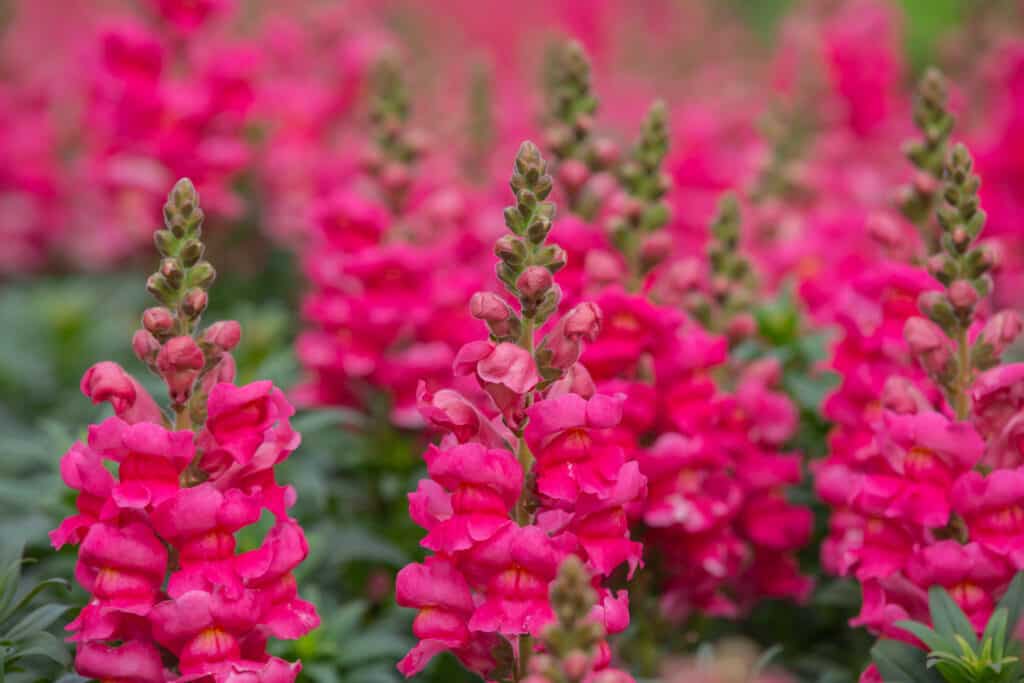
Bees love to hide amongst snapdragon petals while they eat.
©271 EAK MOTO/Shutterstock.com
The photo featured at the top of this post is © Bee on a purple flower/Shutterstock.com
Sources
- North Carolina State University, Available here: https://plants.ces.ncsu.edu/plants/antirrhinum-majus/
- University of Minnesota, Available here: https://extension.umn.edu/flowers/marigolds
- Missouri Botanical Garden, Available here: https://www.missouribotanicalgarden.org/PlantFinder/PlantFinderDetails.aspx?kempercode=b765
- Missouri Botanical Garden, Available here: https://www.missouribotanicalgarden.org/PlantFinder/PlantFinderDetails.aspx?kempercode=g560
- North Carolina State University, Available here: https://plants.ces.ncsu.edu/plants/monarda-didyma/
- North Carolina State University, Available here: https://plants.ces.ncsu.edu/plants/aster/
- North Carolina State University, Available here: https://plants.ces.ncsu.edu/plants/antirrhinum-majus/
- University of Wisconsin, Available here: https://hort.extension.wisc.edu/articles/nasturtium-tropaeolum-majus/
FAQs (Frequently Asked Questions)
What attracts bees the most?
Bees love fragrant things that smell of sugar since nectar is sweet.
Are there any plants bees don’t like?
Bees are not fans of geraniums. They contain almost no pollen, and their attractive color does not get noticed by bees.
What colors do bees like the most?
Bees cannot see the same range of colors we do. However, scientists have determined that they can see and love shades of blues, purples, and violets.
Thank you for reading! Have some feedback for us? Contact the AZ Animals editorial team.






